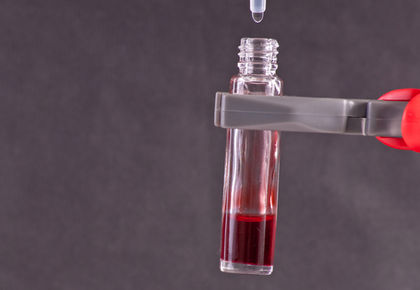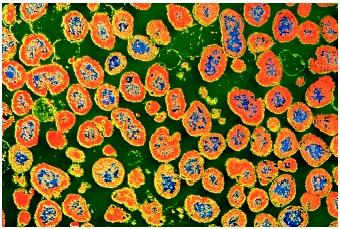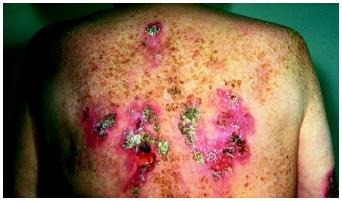Sexually Transmitted Diseases

A sexually transmitted disease (STD) is any disease whose primary (though not necessarily only) mode of transmission is some form of sexual contact. STDs may be viral, bacterial, protistan (protozoan), or fungal. Certain

Bacteria
Gonorrhea. Gonorrhea, one of the most widespread of the STDs, is caused by the bacterium Neisseria gonorrhoeae, some strains of which are resistant to treatment by penicillin as well as the other drugs of choice. The organism itself is quite fragile and cannot survive long enough outside the body to be transmitted from one person to another via infected toilet seats, clothing, or household utensils. It is readily killed by sunlight, drying, or ultraviolet light.
Although any mucous membrane may be affected, the usual gonorrheal infection is found in the genitourinary tract. In the female, the symptoms of gonorrhea are usually mild and may resemble a simple vaginal infection, or they may go completely unnoticed. If left untreated in females, the infection can cause a blockage of the fallopian tubes as well as other pelvic inflammatory diseases. Because of the permanent reproductive tract damage gonorrhea can cause it is often called the "great sterilizer."
In males, the organism often causes a painful infection of the urethra and if left untreated, a complete blockage of the urethra can occur. Other complications of gonorrhea may include damage to the kidneys, heart valves, and joints. The rectal area, conjunctiva , and oral mucosa may also be affected. Because infants can acquire gonorrhea of the conjunctiva while passing through the birth canal of an infected mother, the eyes of newborns are routinely treated with silver nitrate or a penicillin ointment.
Syphilis. Syphilis begins when the spirochete bacterium Treponema pallidum enters the body through a tiny break in the skin. The primary lesion, forming at the site of entry between ten and ninety days after infection, is called a chancre and it is teeming with the spirochetes. This chancre is also normally painless and thus may go undetected, particularly in females if it

In about half the cases, anywhere from several months to twenty or more years after the initial infection, syphilis progresses to the tertiary stage. (Of the remaining cases, about half appear to be cured, and the rest, while not cured, do not seem to progress to the tertiary stage.) Tertiary syphilis may be relatively mild, affecting only the bones or skin; or it may be serious or even fatal, affecting the cardiovascular system (causing such conditions as aortic aneurysms ) or the central nervous system (causing paralysis or syphilitic insanity). In congenital syphilis, the fetus acquires the disease prenatally; the chancre of primary syphilis is bypassed.
Syphilis is usually treated with penicillin, which is especially effective in primary and secondary cases. Other drugs can be used. Treating a pregnant woman also treats her child. As with the gonorrhea organism, Treponema pallidum is quite fragile and cannot survive long enough outside the body to be transmitted from one person to another via infected toilet seats, clothing, or household utensils.
Nongonococcal Urethritis (NGU). Nongonococcal urethritis is a categorical term for any of a number of inflammatory diseases of the sexual organs. By far the most frequently observed of the STDs is chlamydial NGU. Other chlamydial infections include trachoma, an eye disease, and possibly certain arterial plaques and other coronary artery diseases.
Chlamydial NGU. Chlamydial NGU, caused by the obligate intracellular bacterium Chlamydia trachomatis, is also a reportable STD. Chlamydial NGU is often a secondary infection following a gonorrheal infection. Although asymtomatic infections are common in both sexes, in males chlamydial NGU causes urethritis, and in females it causes urethritis, cervicitis, and pelvic inflammatory disease (PID). In serious cases, acute complications such as testicular or prostate swelling in males or the lysing of fallopian tube cells in females can occur.
Pelvic Inflammatory Disease. Pelvic inflammatory disease is a categorical term for any of several inflammations of the pelvic organs. The most common causative agents of PID are Chlamydia trachomatis and Neisseria gonorrhoeae. The specific drug of choice for treatment depends on the cause of the PID. PID is more commonly associated with females than with males. Untreated PIDs can be extremely serious. PID is a leading cause of sterility, particularly among females.
Lymphogranuloma Venereum (LGV). Lymphogranuloma venereumis caused by a specific strain of Chlamydia trachomatis and is one of the most serious of the chlamydial infections. This disease occurs more frequently in males and is characterized by swelling in the groin and in the lymph nodes. The bacteria may also cause proctitis (inflammation of the rectal tissues). Doxycyline is the drug of choice.
Viruses
Herpes. Herpes is a virus or family of viruses (the herpes viruses) causing cold sores, fever blisters, and genital infections. Herpes virus type I (HV1) was formerly thought of as causing problems "above the belt," while Herpes virus type 2 (HV2) has been credited with problems "below the belt." Today it is known that either HV1 or HV2 (including their many serotypes ) can infect any area of the body.
Genital (or anogenital) herpes results in painful blisters of the anus, penis (in males), and cervix, vulva , or vagina (in females). The disease, which can recur at sporadic intervals, is most contagious during the blister stage. Although the disease is incurable, it can be treated. Acyclovir is the drug of choice. Because genital herpes can be passed on through the birth canal, babies of pregnant women with this infection are often delivered by caesarian section. A significant correlation exists in females between genital herpes and cervical cancer.
Genital Warts. Genital warts are caused by a group of papilloma viruses. The presence of these warts in women has been associated with an increased risk of cervical cancer. Warts can be removed surgically, chemically, or by cryotherapy (freezing).
The Hepatitis Viruses. The hepatitis viruses, often identified today as A, B, C, D, and E, are not strictly STDs. However, hepatitis B and hepatitis C can be spread by sexual contact and hepatitis B can be spread in utero.
Protozoans and Yeast
Trichomoniasis. Trichomoniasis is an NGU caused by the protozoan Trichomonas vaginalis. Although usually sexually transmitted, this disease is occasionally acquired from infected toilet or sauna seats, paper towels, or clothing. The organism infects the vagina and urethra of females and affected women experience vaginitis, vaginal discharge, and painful urination. In males the organism can infect the prostate, seminal vesicles , and urethra. The disease seems to be more prevalent among females than males, although males are more likely than females to be asymptomatic .
Candidiasis. Candidiasis, caused by the fungus (yeast) Candida albicans, is an opportunistic disease that often infects the vaginal tract, oral cavity, or respiratory system. The organism can also cause systemic tissue damage.
SEE ALSO AIDS ; Bacterial Cell ; Bacterial Diseases ; Birth Control ; Female Reproductive System ; Fungal Diseases ; Male Reproductive System ; Parasitic Diseases ; Protozoan Diseases ; Viral Diseases
Roberta M. Meehan
Bibliography
Berkow, R. The Merck Manual of Diagnosis and Therapy, 16th ed. Rahway, NJ: Merck Research Laboratories, 1992.
Carlson, K. J., S. A. Eisenstat, and T. Ziparyn. The Harvard Guide to Women's Health. Cambridge, MA: Harvard University Press, 1996.
Center for Disease Control, Division of Sexually Transmitted Diseases. <www.cdc.gov/nchstp/dstd/disease_info.htm> .
Madigan, Michael T., John M. Martinko, and Jack Parker. Brock Biology of Microorganisms, 9th ed. Upper Saddle River, NJ: Prentice Hall, 2000.
EHRLICH, PAUL (1854–1915)
German physician who discovered an effective drug treatment for the sexually transmitted disease syphilis. Ehrlich's drug was the first example of a modern antibiotic, a substance that specifically kills disease-causing organisms without significantly hurting the patient. He won many awards and prizes, including the 1908 Nobel Prize in medicine.
HAZEN, ELIZABETH LEE (1885–1975)
U.S. biologist who, with Rachel Brown (1898–1980), developed the first fungicide. Nystatin is still used to treat dangerous oral and intestinal yeast infections. Hazen was orphaned at age two, attended the first state-supported college for women in the United States, and succeeded against great odds to become a biologist. Hazen and Brown donated all royalties from nystatin—worth more than $13 million—to academic science.
Comment about this article, ask questions, or add new information about this topic: